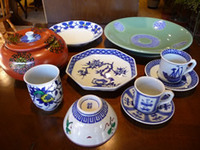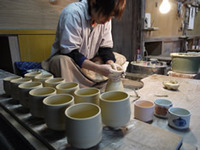

Total:131items
- Pottery & Porcelain (18)
- Koshu Kimen Gawara: Koshu Tile with a Devil’s Face
- Hasami Yaki: Hasami Porcelain
- Kiyomizu Yaki: Kyo style ceramics, Kiyomizu ware
- Otani Yaki: Otani Pottery
- Izushi Yaki: Izushi Porcelain
- Onta-yaki: Onta Pottery
- Takahama Yaki: Takahama Porcelain
- Mushiake- Yaki: Mushiake ware
- Kikuma-Gawara: Kikuma Roof-Tile
- Zeze-Yaki: Zeze ware
- TsutsumiYaki: Tsutsumi Pottery
- Hira Shimizu Yaki: Hira Shimizu Ware
- Tajima Banko Yaki: Tajima Banko Pottery
- Shidoro-Yaki: Shidoro Ware
- Amakusa Tojiki: Amakusa ware
- Shibukusa-yaki: Shibukusa ware
- Karatsu Yaki : Karatsu Ware
- Satsuma-yaki : Satsuma Ware
- Lacquerware (4)
- Glasswork (2)
- Wood & Bamboo Work (19)
- Leather Work (1)
- Papermaking (13)
- Textile (20)
- Dyeing products (5)
- Masonry (1)
- Metal Work (11)
- Stationery (4)
- Livingware (3)
- Accessory (4)
- Toys & Entertainment (14)
- Interior (2)
- Other crafts (10)

 |
Main Production Site:Gifu |
 《Characteristics》
《Characteristics》“Shibukusa-yaki (Shibukusa ware)” is handmade, and hand painted pottery and porcelain. The making of Shibukusa-yaki has continued since the late Edo period (17-19c) in Hida Takayama (Gifu Prefecture, central Japan).
Its production began in 1841. At the time, Hida Takayama was a region under the Edo Shogunate’s direct control called Tenryo. Hida Gundai, or the local magistrate of Hida in Takayama Jinya, or Takayama magistrate's office, TOYODA Fujinoshin aimed to develop a new local industry by having purveyors produce ceramic ware at a semi-governmental manufacturing site, present day “Shibukusa” production site.
At the beginning, craftsmen were gathered from distinguished ceramic production sites such as Owari Seto, present day Aichi Pref., and Kaga Kutani, present day Ishikawa Pref., both in central Japan (craftsmen include TODA Ryuzo, KOBAYASHI Ihei, KAWAKAMI Tokisuke, SOGA Chikuzan, Fujizo, Shuzan). The primary material used for the products was kaolin from Hida area.
Based on the methods acquired from Kutani, Arita, Kyoto, Seto and Mino, all of which are renowned porcelain production sites, artisans of Shibukusa ware strive for creating its uniqueness on its rich white surface to date. It is produced with various techniques, such as sometsuke (underglaze blue), aka-e (paintings in red), celadon and white porcelain while maintaining its traditional handmade and hand painting techniques.
[Designated Local Handicraft of Gifu Prefecture]
Information provided by: Shibukusa-yaki Pottery Houkokusha
Translation by: Yoshiko Nagao

| Materials | kaolin |
|---|---|
| Crafting Processes | 【1】 Forming
Shape by potter’s wheel or casting in plaster mold. 【2】 Smoothing and biscuit firing Biscuit fire in 800℃ for 8 hours after smoothing the surface and drying. 【3】 Underglaze decoration Draw a rough sketch with Gosu (asbolite) after biscuit firing. 【4】 Glazing Glaze over the underglazed work. 【5】 Glost firing Glost fire at 1300℃ for 22 hours. 【6】 Overglaze painting Overglaze paint using overglaze color after glost firing. 【7】 Overglaze firing Overglaze fire at 800℃ for 9 hours to complete. |
| History | Shibukusa ware is still produced in the same building as in the old days.
It became known as Shibukusa-yaki after the name of the land “Shibukusa”. Takayama used to be under the Edo Shogunate’s direct control (Tenryo). In 1841, then Hida Gundai, or the local magistrate of Hida in Takayama Jinya, or Takayama magistrate's office, TOYODA Fujinoshin aimed to develop a new local industry by having purveyors plan the production of ceramics and open a parastatal kiln in the place called “Shibukusa” where the current production site is. This is the beginning of Shibukusa ware. At the beginning, craftsmen were gathered from distinguished ceramic production sites such as Owari Seto, present day Aichi Pref., and Kaga Kutani, present day Ishikawa Pref., both in central Japan (craftsmen include TODA Ryuzo, KOBAYASHI Ihei, KAWAKAMI Tokisuke, SOGA Chikuzan, Fujizo, Shuzan). The primary material used was quality pottery stone (Shibukusa pottery stone) extracted locally and fine works such as Hida Kutani and Hida Akae were produced. As Hida was under the Edo Shogunate’s direct control (Tenryo), the disorders around the last days of the Edo period (19c) greatly impacted the area, because of the demolition of the shogunate administration. The support from the Jinya, or the magistrate's office for Shibukusa-yaki was no longer available. After TODA Ryuzo’s death, the production of Shibukusa-yaki was continued in a small scale until its full restoration in 1878. In 1878, MIWA Genjiro who came from a distinguished family and was also an entrepreneur called upon the like such as NAGATA Kichiemon, HIRASE Ichibei, and SAKATA Chogoro to form a four member union organization to restore the ceramic industry and created the company named “Toukensha”. Thereafter, in 1879 the company was named “Houkokusha” by KATSU Kaishu, a renowned shogunate official and Meiji politician, and a Genkun (oligarch with merit) of the Meiji Government GOTO Shojiro. The notification of establishment of a company to the governor was submitted. In order to create better works, craftsmen were sent off to Kyoto and Arita to study with emphasis on improving their techniques. Techniques have been succeeded by generations of craftsmen and the works created are prestigiously noted at exhibitions such as the Paris Exposition and similar expositions around the world, Japan-British Exhibition, and competitive exhibitions held domestically. These works are exhibited as works of “Houkokusha” and not per individual artist names. |
| Related URL | http://www.shibukusa.co.jp/ |
◆Exhibition / Showcase
Hida Takayama ware Shibukusa-yaki (Houkokusha) Direct shop
(Purchase of Shibukusa-yaki is available)
Address: 63 Kamininomachi, Takayama City Gifu Prefecture, 506-0845
TEL: +81-(0)577-34-0504 (Japanese only)
◆Event Information
Assistance needed? For inquiries in English:
JTCO Contact Form
Your inquiries will be forwarded by JTCO in Japanese to the organization you wish to contact.
*Please write the name of craft you wish to ask about.



